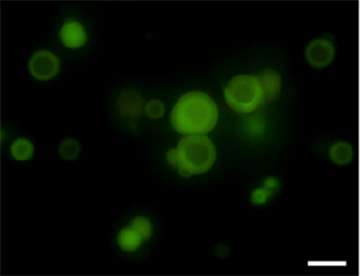Coated droplets hint at formation of early cells

(Phys.org) —Researchers at the University of Bristol have designed a chemical system that brings together alternative ideas on how primitive cells were formed on the early Earth to produce a new model of protocell organization. The work is described in an article published this week in Nature Chemistry.
The most fundamental requirement for the emergence of cells on the early Earth is the existence of a closed compartment, but how this came about remains a mystery.
Two alternative theories based on the self-assembly of fatty acid membrane-bounded water droplets (vesicles) or the spontaneous phase separation of membrane-free liquid droplets (coacervates) are being tested experimentally, but neither model is fully satisfactory.
Professor Stephen Mann and Dr Dora Tang, with colleagues in the new Bristol Centre for Protolife Research in the School of Chemistry and collaborators at Imperial College London, have now addressed this problem by designing and constructing a new type of protocell that integrates aspects of both hypotheses to produce a hybrid model of prebiotic organization.
The team first prepared membrane-free droplets containing high concentrations of biomolecules such as adenosine triphosphate (ATP), ribonucleic acid (RNA) and a short or long polymer of the natural amino acid lysine, and then added low amounts of a fatty acid.
The concentration of the fatty acid was too low for the molecules to self-organize into vesicles, and instead they became attached to the surface of the droplets to produce a continuous organic membrane. In this way, the researchers were able to produce protocells that were both membrane-bounded and chemically enriched.
Professor Stephen Mann said: "This work could open up a new horizon in protocell research as it offers an integrated approach to the problem of how the first cells were formed and organized.
"Our new hybrid model can be easily developed towards more complex systems, and designed and tested for new types of functions. For example, we hope to use the new design principle to study the membrane-mediated regulation of biological reactions inside coacervate droplets."
More information: "Fatty acid membrane assembly on coacervate microdroplets as a step towards a hybrid protocell model." T-Y. Dora Tang, et al. Nature Chemistry (2014) DOI: 10.1038/nchem.1921. Received 01 October 2013 Accepted 13 March 2014 Published online 20 April 2014
Journal information: Nature Chemistry
Provided by University of Bristol



















